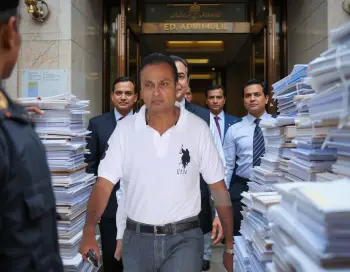ED Makes First Arrest in ₹3,000-Crore Loan Fraud Case Against Anil Ambani Group
Mumbai, August 2, 2025 — In a pivotal moment for India’s financial crime investigation landscape, the Enforcement Directorate (ED) has made its first arrest in the ₹3,000-crore loan fraud case against Anil Ambani‘s Reliance ADA Group. The high-stakes probe, which has captivated the country’s attention for over a year, now moves into an active prosecution phase with the arrest of a senior executive connected to the group’s finance wing.
According to sources within the ED, the arrest was made late Thursday night after weeks of forensic analysis and multiple rounds of questioning. Officials say the individual played a “key operational role” in allegedly routing public sector bank loans through a web of suspicious transactions and shell firms.
The Anatomy of the ₹3,000-Crore Scam
The loan fraud case against Anil Ambani began unraveling following a referral from the Central Bureau of Investigation (CBI), which flagged irregularities in loans sanctioned between 2015 and 2019. These loans, sanctioned by a consortium of banks to Reliance Infrastructure and Reliance Power, were intended for infrastructure and energy projects.
However, ED investigators now allege that these funds were:
- Diverted via over two dozen shell companies
- Transferred offshore without proper disclosure
- Used for debt servicing and unrelated expenses
- Supported by fabricated invoices and over-inflated project valuations
A senior official involved in the probe stated: “The scale of deception and financial layering in the loan fraud case against Anil Ambani is unprecedented. The forensic evidence is compelling.”
What Triggered the Arrest
The arrested executive was allegedly responsible for authorizing multiple transfers that contradicted RBI’s external commercial borrowing norms. The ED suspects that these actions were part of a well-planned scheme to recycle loan funds without alerting statutory bodies.
Documents seized during raids reportedly reveal:
- Falsified board meeting minutes
- Dummy vendors issuing inflated bills
- Transaction records suggesting round-tripping of funds
Investigators believe these findings justify further custodial interrogations and asset freezes under the Prevention of Money Laundering Act (PMLA), 2002.
Anil Ambani’s Reaction to the Allegations
Anil Ambani has publicly denied any involvement in the alleged scam, stating through legal representatives: “All financial operations were carried out within the bounds of law. We will extend full cooperation to the authorities.”
While the Reliance ADA Group claims that Anil Ambani was not involved in daily management, investigators assert that “decision-level accountability” cannot be ruled out—especially considering the executive arrested was part of Ambani’s inner circle.
Systemic Red Flags: The Role of Banks and Auditors
The loan fraud case against Anil Ambani also raises pressing questions about institutional oversight. Industry experts argue that this case exposes a major loophole in banking compliance systems.
Some key concerns include:
- How loan disbursement continued despite project delays
- Why shell companies with negligible revenue received large sums
- Why auditors did not red-flag duplicate invoicing practices
The RBI is reportedly reviewing the bank’s exposure reports and may initiate penalties or action under the Banking Regulation Act.
Implications for India Inc. and Future of Financial Oversight
The arrest comes at a time when regulatory bodies are tightening their grip on financial irregularities by corporate giants. With India aiming to position itself as a global economic hub, the loan fraud case against Anil Ambani could become a landmark in curbing white-collar crime.
Former SEBI member D.R. Mehta commented, “This case will have a deterrent effect across India Inc. Executives can no longer assume legal immunity behind corporate veils.”

Conclusion: Will the Case Reshape Corporate Accountability?
The ED’s arrest has significantly escalated the loan fraud case against Anil Ambani, making it one of India’s most consequential financial probes in recent times. More arrests and asset seizures are likely as the investigation gains momentum. Whether this leads to a broader cleanup in corporate financing or merely another closed file will depend on the tenacity of the prosecution and transparency of the process.
❓FAQs: Loan Fraud Case Against Anil Ambani Group
1. What is the loan fraud case against Anil Ambani about?
The loan fraud case against Anil Ambani involves the alleged diversion of ₹3,000 crore in bank loans by companies under the Reliance ADA Group. These funds were reportedly misused via shell companies, inflated invoices, and unauthorized offshore transfers, violating both banking and financial laws.
2. Who has been arrested in the loan fraud case against Anil Ambani?
The Enforcement Directorate arrested a senior executive from the finance department of the Reliance ADA Group. He is believed to have played a central role in fund diversion and manipulation of loan-related documents in the ongoing loan fraud case against Anil Ambani.
3. Which companies are under investigation in the loan fraud case against Anil Ambani?
Reliance Infrastructure and Reliance Power, both key entities under the Anil Dhirubhai Ambani Group, are the main companies under scrutiny in the loan fraud case against Anil Ambani. Multiple shell companies allegedly linked to them are also being audited.
4. How did the ED uncover the loan fraud case against Anil Ambani?
The ED launched its probe based on a CBI referral. Through forensic audits, email trails, and transaction mapping, investigators identified irregular financial flows and offshore fund movements, leading to the discovery of the loan fraud case against Anil Ambani.
Also Read : Artificial Intelligence and Machine Learning: Everything You Need to Know in 2025
5. Has Anil Ambani responded to the allegations?
Yes. Anil Ambani, through his legal team, has denied any involvement in the day-to-day decisions that led to the alleged misuse of funds. He claims the operations were lawful and that he will cooperate in the loan fraud case against Anil Ambani.
6. What is the legal framework used in this investigation?
The ED is proceeding under the Prevention of Money Laundering Act (PMLA), 2002. The law empowers them to arrest, seize assets, and interrogate individuals linked to financial crimes, including the loan fraud case against Anil Ambani.
7. What role did banks play in the loan fraud case against Anil Ambani?
The banks involved in disbursing the ₹3,000-crore loans allegedly failed to monitor end-use. Despite poor project performance and questionable vendors, loans continued, raising compliance concerns that are now central to the loan fraud case against Anil Ambani.
8. Are more arrests expected in the loan fraud case against Anil Ambani?
Yes. ED officials have indicated that more arrests may follow as they unravel additional evidence in the loan fraud case against Anil Ambani. Senior managers, auditors, and financial consultants are reportedly under surveillance.
9. How might this case affect Anil Ambani’s business empire?
The ongoing investigation could severely impact investor trust, stock performance, and future funding prospects. If proven, the loan fraud case against Anil Ambani could lead to asset attachments and legal penalties.
10. What is the broader impact of this case on corporate governance in India?
This case is seen as a wake-up call for Indian regulators, investors, and institutions. The loan fraud case against Anil Ambani could catalyze stricter financial checks, improved auditor accountability, and reinforced loan monitoring mechanisms.
For all latest news updates about politics, entertainment, technology, health and economy do visit Premiere News website, Facebook, Instagram and Twitter accounts.




